2001 CHRYSLER VOYAGER Engine
[x] Cancel search: EnginePage 3996 of 4284
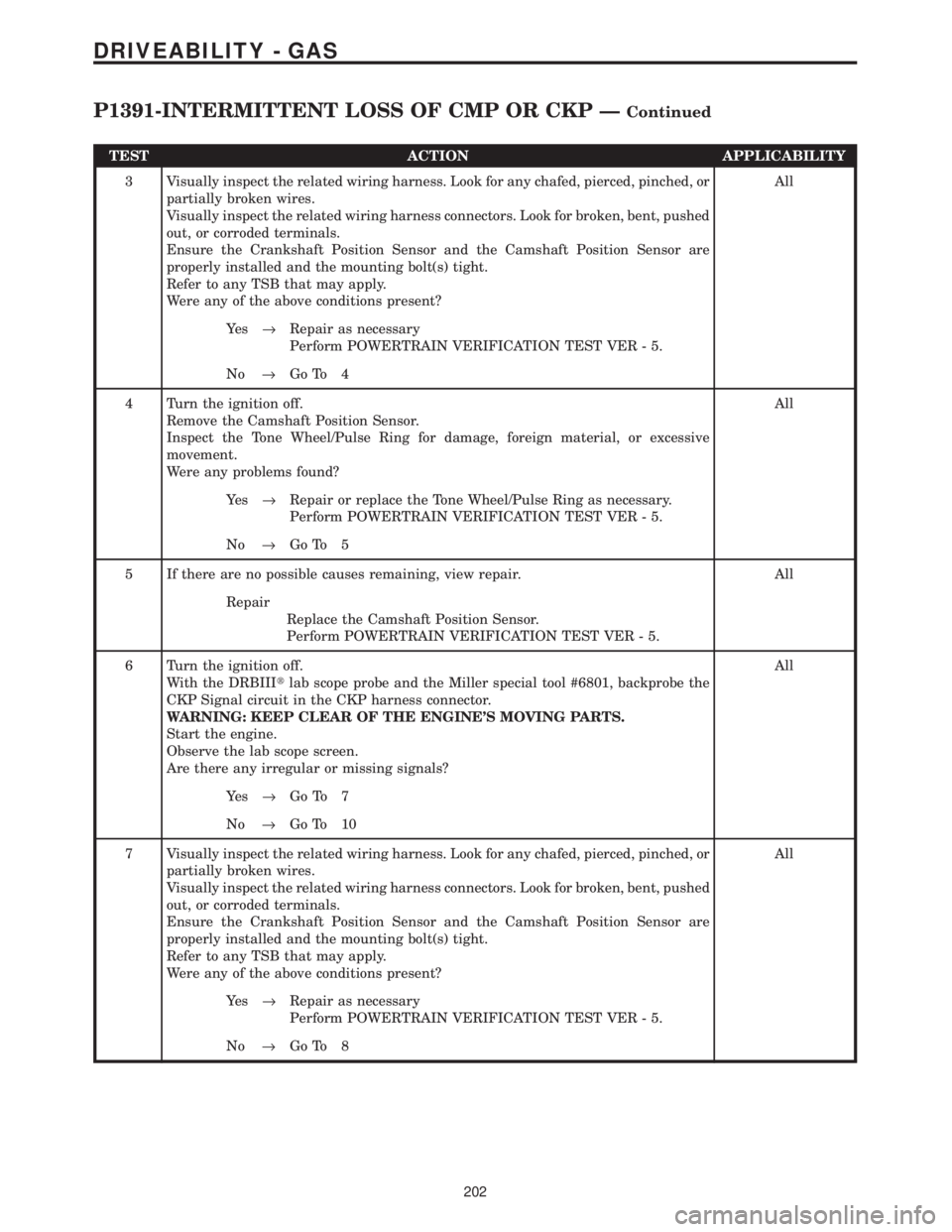
TEST ACTION APPLICABILITY
3 Visually inspect the related wiring harness. Look for any chafed, pierced, pinched, or
partially broken wires.
Visually inspect the related wiring harness connectors. Look for broken, bent, pushed
out, or corroded terminals.
Ensure the Crankshaft Position Sensor and the Camshaft Position Sensor are
properly installed and the mounting bolt(s) tight.
Refer to any TSB that may apply.
Were any of the above conditions present?All
Ye s®Repair as necessary
Perform POWERTRAIN VERIFICATION TEST VER - 5.
No®Go To 4
4 Turn the ignition off.
Remove the Camshaft Position Sensor.
Inspect the Tone Wheel/Pulse Ring for damage, foreign material, or excessive
movement.
Were any problems found?All
Ye s®Repair or replace the Tone Wheel/Pulse Ring as necessary.
Perform POWERTRAIN VERIFICATION TEST VER - 5.
No®Go To 5
5 If there are no possible causes remaining, view repair. All
Repair
Replace the Camshaft Position Sensor.
Perform POWERTRAIN VERIFICATION TEST VER - 5.
6 Turn the ignition off.
With the DRBIIItlab scope probe and the Miller special tool #6801, backprobe the
CKP Signal circuit in the CKP harness connector.
WARNING: KEEP CLEAR OF THE ENGINE'S MOVING PARTS.
Start the engine.
Observe the lab scope screen.
Are there any irregular or missing signals?All
Ye s®Go To 7
No®Go To 10
7 Visually inspect the related wiring harness. Look for any chafed, pierced, pinched, or
partially broken wires.
Visually inspect the related wiring harness connectors. Look for broken, bent, pushed
out, or corroded terminals.
Ensure the Crankshaft Position Sensor and the Camshaft Position Sensor are
properly installed and the mounting bolt(s) tight.
Refer to any TSB that may apply.
Were any of the above conditions present?All
Ye s®Repair as necessary
Perform POWERTRAIN VERIFICATION TEST VER - 5.
No®Go To 8
202
DRIVEABILITY - GAS
P1391-INTERMITTENT LOSS OF CMP OR CKP ÐContinued
Page 3997 of 4284
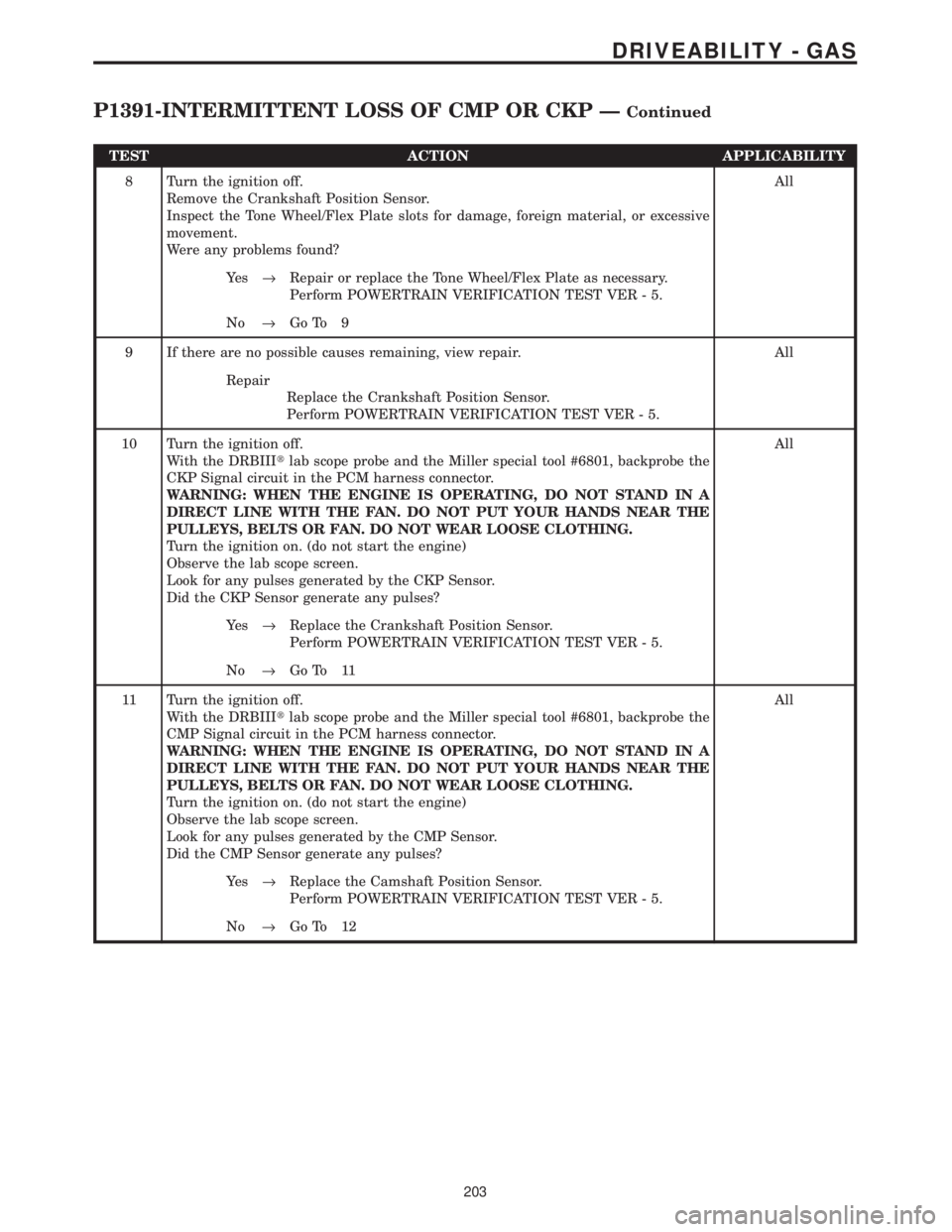
TEST ACTION APPLICABILITY
8 Turn the ignition off.
Remove the Crankshaft Position Sensor.
Inspect the Tone Wheel/Flex Plate slots for damage, foreign material, or excessive
movement.
Were any problems found?All
Ye s®Repair or replace the Tone Wheel/Flex Plate as necessary.
Perform POWERTRAIN VERIFICATION TEST VER - 5.
No®Go To 9
9 If there are no possible causes remaining, view repair. All
Repair
Replace the Crankshaft Position Sensor.
Perform POWERTRAIN VERIFICATION TEST VER - 5.
10 Turn the ignition off.
With the DRBIIItlab scope probe and the Miller special tool #6801, backprobe the
CKP Signal circuit in the PCM harness connector.
WARNING: WHEN THE ENGINE IS OPERATING, DO NOT STAND IN A
DIRECT LINE WITH THE FAN. DO NOT PUT YOUR HANDS NEAR THE
PULLEYS, BELTS OR FAN. DO NOT WEAR LOOSE CLOTHING.
Turn the ignition on. (do not start the engine)
Observe the lab scope screen.
Look for any pulses generated by the CKP Sensor.
Did the CKP Sensor generate any pulses?All
Ye s®Replace the Crankshaft Position Sensor.
Perform POWERTRAIN VERIFICATION TEST VER - 5.
No®Go To 11
11 Turn the ignition off.
With the DRBIIItlab scope probe and the Miller special tool #6801, backprobe the
CMP Signal circuit in the PCM harness connector.
WARNING: WHEN THE ENGINE IS OPERATING, DO NOT STAND IN A
DIRECT LINE WITH THE FAN. DO NOT PUT YOUR HANDS NEAR THE
PULLEYS, BELTS OR FAN. DO NOT WEAR LOOSE CLOTHING.
Turn the ignition on. (do not start the engine)
Observe the lab scope screen.
Look for any pulses generated by the CMP Sensor.
Did the CMP Sensor generate any pulses?All
Ye s®Replace the Camshaft Position Sensor.
Perform POWERTRAIN VERIFICATION TEST VER - 5.
No®Go To 12
203
DRIVEABILITY - GAS
P1391-INTERMITTENT LOSS OF CMP OR CKP ÐContinued
Page 3998 of 4284
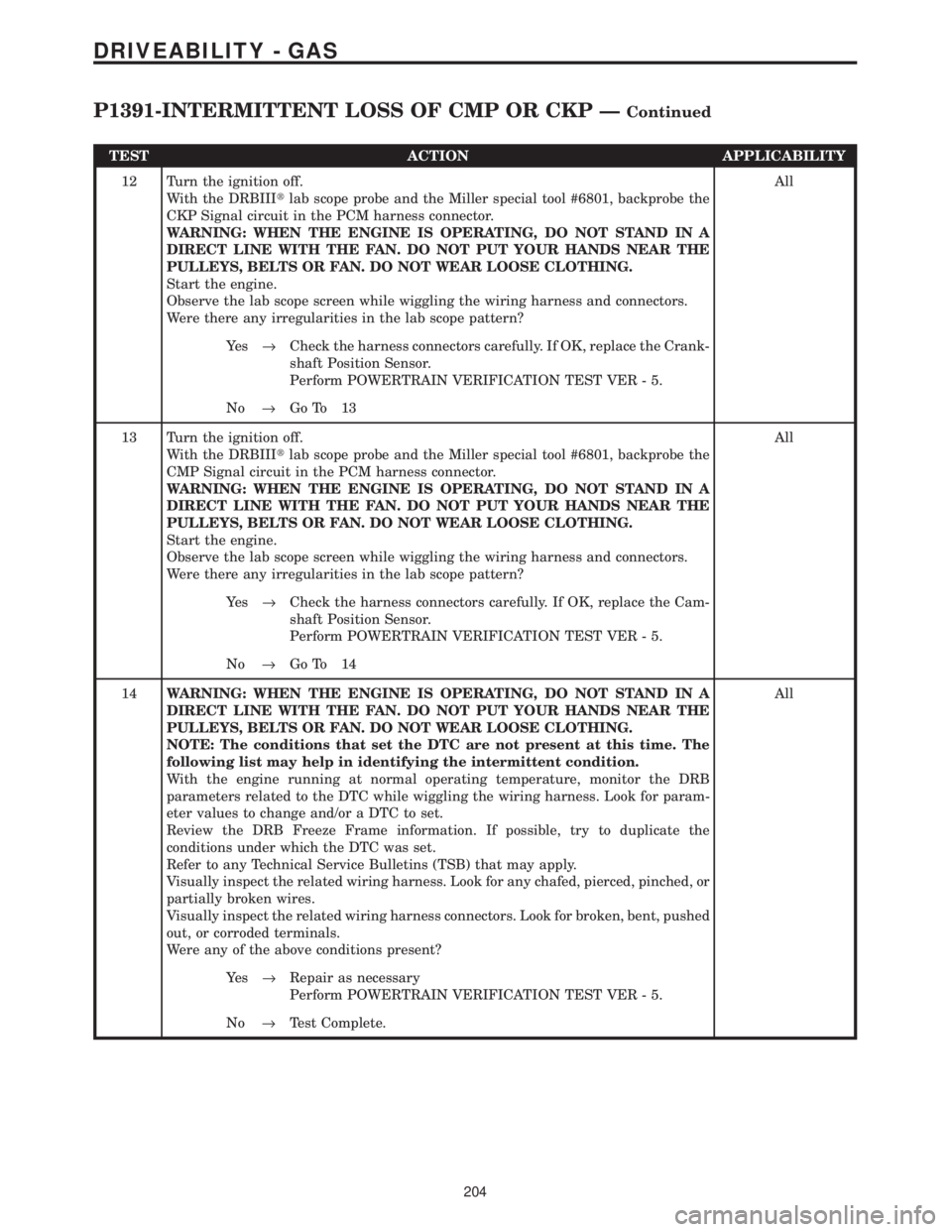
TEST ACTION APPLICABILITY
12 Turn the ignition off.
With the DRBIIItlab scope probe and the Miller special tool #6801, backprobe the
CKP Signal circuit in the PCM harness connector.
WARNING: WHEN THE ENGINE IS OPERATING, DO NOT STAND IN A
DIRECT LINE WITH THE FAN. DO NOT PUT YOUR HANDS NEAR THE
PULLEYS, BELTS OR FAN. DO NOT WEAR LOOSE CLOTHING.
Start the engine.
Observe the lab scope screen while wiggling the wiring harness and connectors.
Were there any irregularities in the lab scope pattern?All
Ye s®Check the harness connectors carefully. If OK, replace the Crank-
shaft Position Sensor.
Perform POWERTRAIN VERIFICATION TEST VER - 5.
No®Go To 13
13 Turn the ignition off.
With the DRBIIItlab scope probe and the Miller special tool #6801, backprobe the
CMP Signal circuit in the PCM harness connector.
WARNING: WHEN THE ENGINE IS OPERATING, DO NOT STAND IN A
DIRECT LINE WITH THE FAN. DO NOT PUT YOUR HANDS NEAR THE
PULLEYS, BELTS OR FAN. DO NOT WEAR LOOSE CLOTHING.
Start the engine.
Observe the lab scope screen while wiggling the wiring harness and connectors.
Were there any irregularities in the lab scope pattern?All
Ye s®Check the harness connectors carefully. If OK, replace the Cam-
shaft Position Sensor.
Perform POWERTRAIN VERIFICATION TEST VER - 5.
No®Go To 14
14WARNING: WHEN THE ENGINE IS OPERATING, DO NOT STAND IN A
DIRECT LINE WITH THE FAN. DO NOT PUT YOUR HANDS NEAR THE
PULLEYS, BELTS OR FAN. DO NOT WEAR LOOSE CLOTHING.
NOTE: The conditions that set the DTC are not present at this time. The
following list may help in identifying the intermittent condition.
With the engine running at normal operating temperature, monitor the DRB
parameters related to the DTC while wiggling the wiring harness. Look for param-
eter values to change and/or a DTC to set.
Review the DRB Freeze Frame information. If possible, try to duplicate the
conditions under which the DTC was set.
Refer to any Technical Service Bulletins (TSB) that may apply.
Visually inspect the related wiring harness. Look for any chafed, pierced, pinched, or
partially broken wires.
Visually inspect the related wiring harness connectors. Look for broken, bent, pushed
out, or corroded terminals.
Were any of the above conditions present?All
Ye s®Repair as necessary
Perform POWERTRAIN VERIFICATION TEST VER - 5.
No®Test Complete.
204
DRIVEABILITY - GAS
P1391-INTERMITTENT LOSS OF CMP OR CKP ÐContinued
Page 3999 of 4284
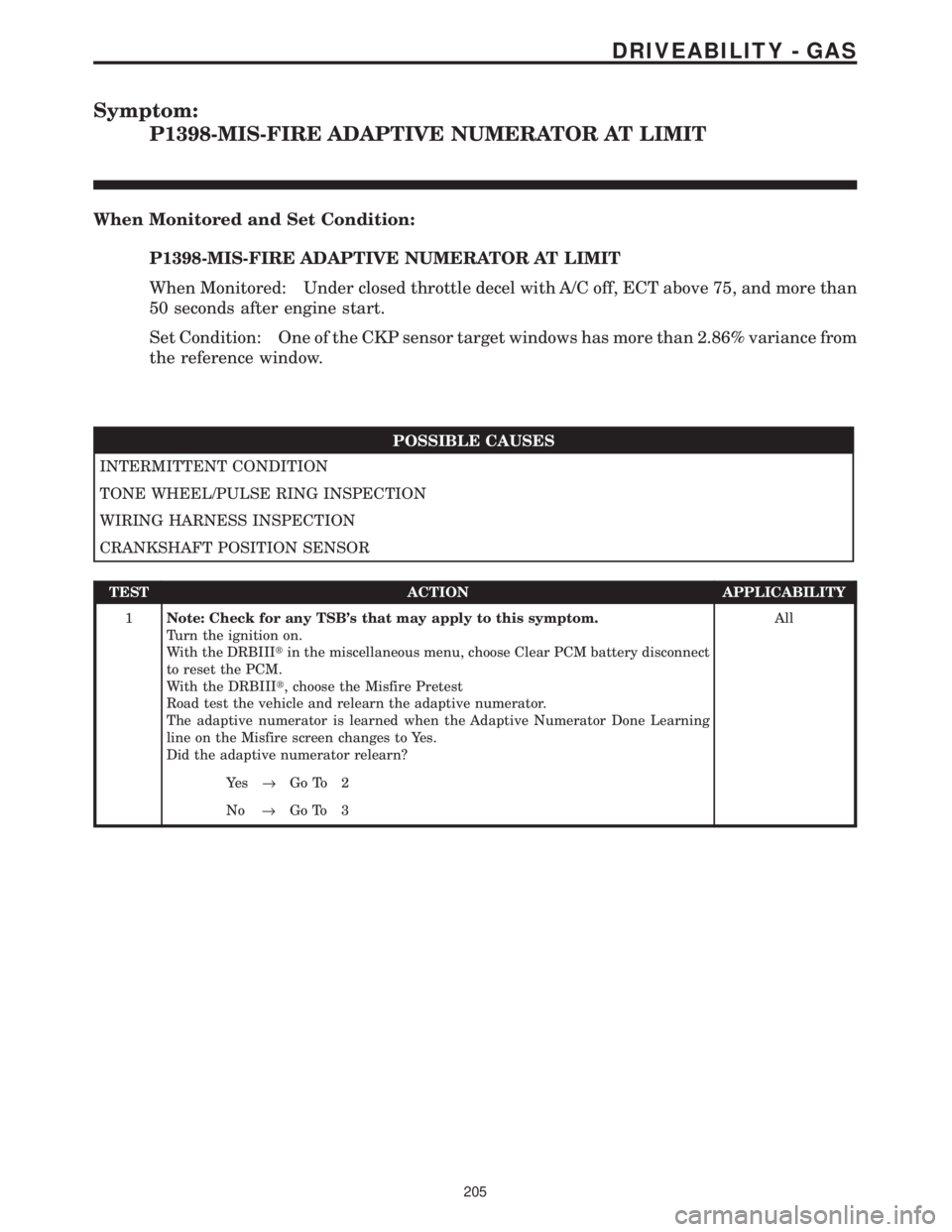
Symptom:
P1398-MIS-FIRE ADAPTIVE NUMERATOR AT LIMIT
When Monitored and Set Condition:
P1398-MIS-FIRE ADAPTIVE NUMERATOR AT LIMIT
When Monitored: Under closed throttle decel with A/C off, ECT above 75, and more than
50 seconds after engine start.
Set Condition: One of the CKP sensor target windows has more than 2.86% variance from
the reference window.
POSSIBLE CAUSES
INTERMITTENT CONDITION
TONE WHEEL/PULSE RING INSPECTION
WIRING HARNESS INSPECTION
CRANKSHAFT POSITION SENSOR
TEST ACTION APPLICABILITY
1Note: Check for any TSB's that may apply to this symptom.
Turn the ignition on.
With the DRBIIItin the miscellaneous menu, choose Clear PCM battery disconnect
to reset the PCM.
With the DRBIIIt, choose the Misfire Pretest
Road test the vehicle and relearn the adaptive numerator.
The adaptive numerator is learned when the Adaptive Numerator Done Learning
line on the Misfire screen changes to Yes.
Did the adaptive numerator relearn?All
Ye s®Go To 2
No®Go To 3
205
DRIVEABILITY - GAS
Page 4000 of 4284

TEST ACTION APPLICABILITY
2WARNING: WHEN THE ENGINE IS OPERATING, DO NOT STAND IN A
DIRECT LINE WITH THE FAN. DO NOT PUT YOUR HANDS NEAR THE
PULLEYS, BELTS OR FAN. DO NOT WEAR LOOSE CLOTHING.
NOTE: The conditions that set the DTC are not present at this time. The
following list may help in identifying the intermittent condition.
With the engine running at normal operating temperature, monitor the DRB
parameters related to the DTC while wiggling the wiring harness. Look for param-
eter values to change and/or a DTC to set.
Review the DRB Freeze Frame information. If possible, try to duplicate the
conditions under which the DTC was set.
Refer to any Technical Service Bulletins (TSB) that may apply.
Visually inspect the related wiring harness. Look for any chafed, pierced, pinched, or
partially broken wires.
Visually inspect the related wiring harness connectors. Look for broken, bent, pushed
out, or corroded terminals.
Were any of the above conditions present?All
Ye s®Repair as necessary
Perform POWERTRAIN VERIFICATION TEST VER - 5.
No®Test Complete.
3 Visually inspect the CKP wiring harness. Look for any chafed, pierced, pinched, or
partially broken wires.
Visually inspect the CKP wiring harness connectors. Look for broken, bent, pushed
out, or corroded terminals.
Ensure the Crankshaft Position Sensor properly installed and the mounting bolt(s)
tight.
Refer to any TSB that may apply.
Were any of the above conditions present?All
Ye s®Repair as necessary
Perform POWERTRAIN VERIFICATION TEST VER - 5.
No®Go To 4
4 Turn the ignition off.
Remove the Crankshaft Position Sensor.
Inspect the Tone Wheel/Flex Plate slots for damage, foreign material, or excessive
movement.
Were any problems found?All
Ye s®Repair or replace the Tone Wheel/Flex Plate as necessary.
Perform POWERTRAIN VERIFICATION TEST VER - 5.
No®Go To 5
5 If there are no possible causes remaining, view repair. All
Repair
Replace the Crankshaft Position Sensor.
Perform POWERTRAIN VERIFICATION TEST VER - 5.
206
DRIVEABILITY - GAS
P1398-MIS-FIRE ADAPTIVE NUMERATOR AT LIMIT ÐContinued
Page 4005 of 4284
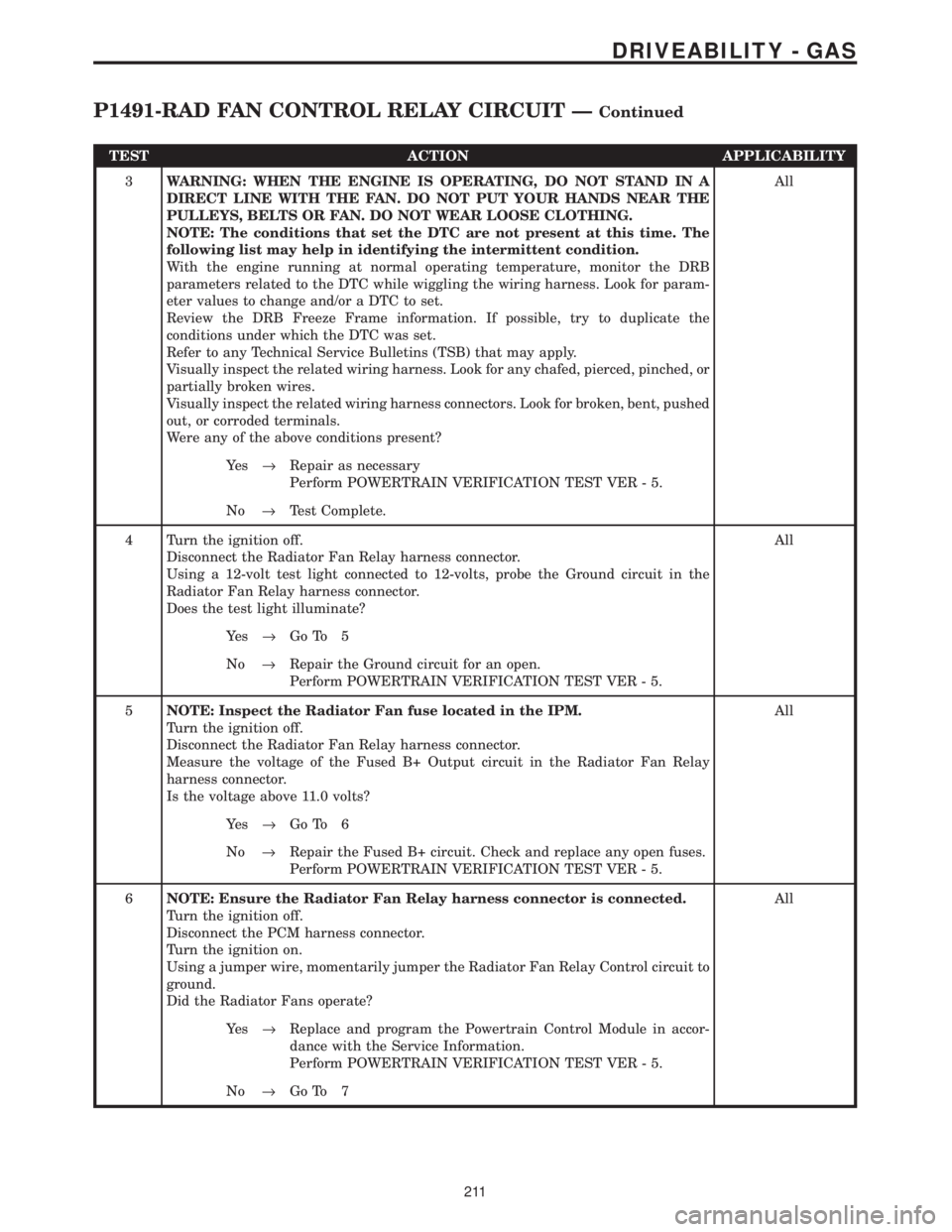
TEST ACTION APPLICABILITY
3WARNING: WHEN THE ENGINE IS OPERATING, DO NOT STAND IN A
DIRECT LINE WITH THE FAN. DO NOT PUT YOUR HANDS NEAR THE
PULLEYS, BELTS OR FAN. DO NOT WEAR LOOSE CLOTHING.
NOTE: The conditions that set the DTC are not present at this time. The
following list may help in identifying the intermittent condition.
With the engine running at normal operating temperature, monitor the DRB
parameters related to the DTC while wiggling the wiring harness. Look for param-
eter values to change and/or a DTC to set.
Review the DRB Freeze Frame information. If possible, try to duplicate the
conditions under which the DTC was set.
Refer to any Technical Service Bulletins (TSB) that may apply.
Visually inspect the related wiring harness. Look for any chafed, pierced, pinched, or
partially broken wires.
Visually inspect the related wiring harness connectors. Look for broken, bent, pushed
out, or corroded terminals.
Were any of the above conditions present?All
Ye s®Repair as necessary
Perform POWERTRAIN VERIFICATION TEST VER - 5.
No®Test Complete.
4 Turn the ignition off.
Disconnect the Radiator Fan Relay harness connector.
Using a 12-volt test light connected to 12-volts, probe the Ground circuit in the
Radiator Fan Relay harness connector.
Does the test light illuminate?All
Ye s®Go To 5
No®Repair the Ground circuit for an open.
Perform POWERTRAIN VERIFICATION TEST VER - 5.
5NOTE: Inspect the Radiator Fan fuse located in the IPM.
Turn the ignition off.
Disconnect the Radiator Fan Relay harness connector.
Measure the voltage of the Fused B+ Output circuit in the Radiator Fan Relay
harness connector.
Is the voltage above 11.0 volts?All
Ye s®Go To 6
No®Repair the Fused B+ circuit. Check and replace any open fuses.
Perform POWERTRAIN VERIFICATION TEST VER - 5.
6NOTE: Ensure the Radiator Fan Relay harness connector is connected.
Turn the ignition off.
Disconnect the PCM harness connector.
Turn the ignition on.
Using a jumper wire, momentarily jumper the Radiator Fan Relay Control circuit to
ground.
Did the Radiator Fans operate?All
Ye s®Replace and program the Powertrain Control Module in accor-
dance with the Service Information.
Perform POWERTRAIN VERIFICATION TEST VER - 5.
No®Go To 7
211
DRIVEABILITY - GAS
P1491-RAD FAN CONTROL RELAY CIRCUIT ÐContinued
Page 4008 of 4284
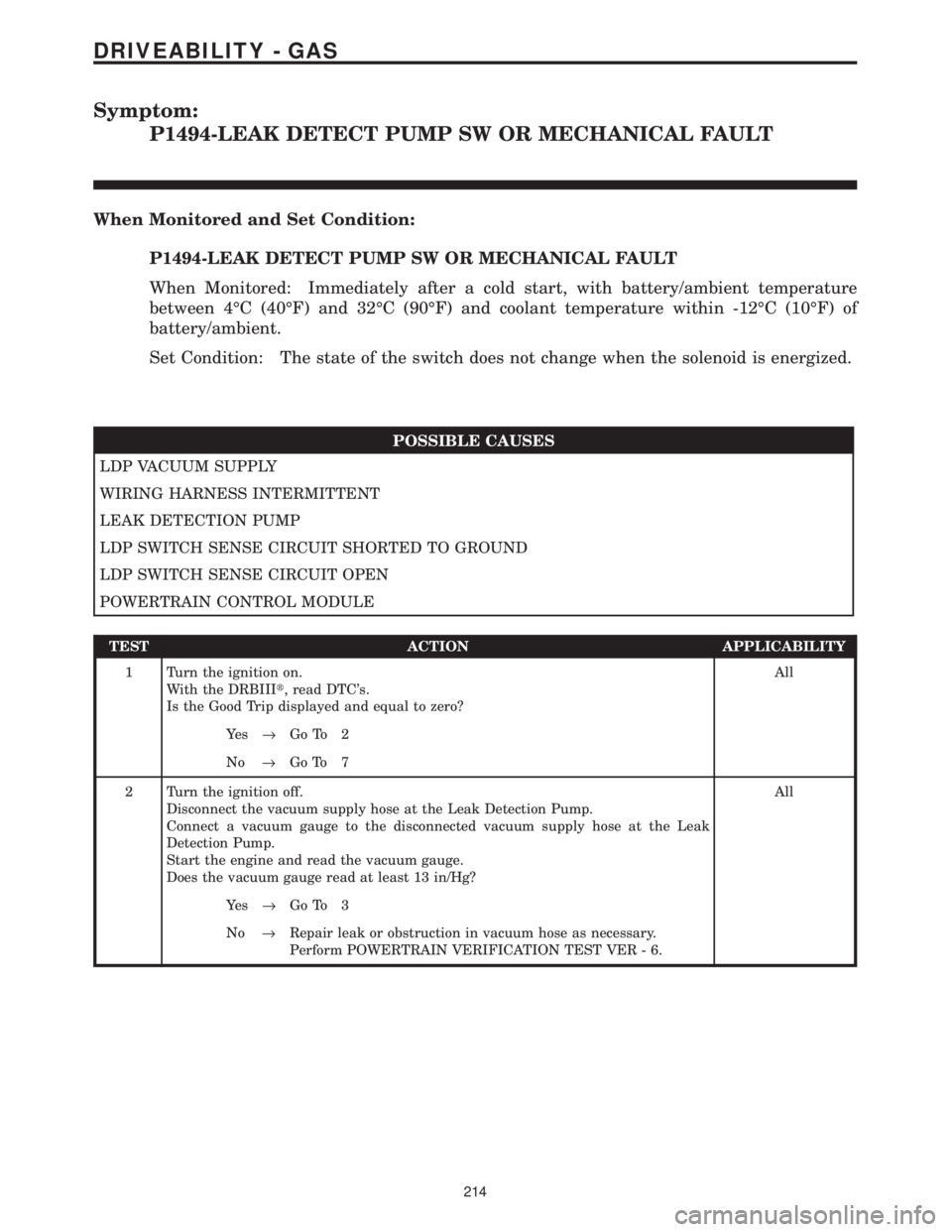
Symptom:
P1494-LEAK DETECT PUMP SW OR MECHANICAL FAULT
When Monitored and Set Condition:
P1494-LEAK DETECT PUMP SW OR MECHANICAL FAULT
When Monitored: Immediately after a cold start, with battery/ambient temperature
between 4ÉC (40ÉF) and 32ÉC (90ÉF) and coolant temperature within -12ÉC (10ÉF) of
battery/ambient.
Set Condition: The state of the switch does not change when the solenoid is energized.
POSSIBLE CAUSES
LDP VACUUM SUPPLY
WIRING HARNESS INTERMITTENT
LEAK DETECTION PUMP
LDP SWITCH SENSE CIRCUIT SHORTED TO GROUND
LDP SWITCH SENSE CIRCUIT OPEN
POWERTRAIN CONTROL MODULE
TEST ACTION APPLICABILITY
1 Turn the ignition on.
With the DRBIIIt, read DTC's.
Is the Good Trip displayed and equal to zero?All
Ye s®Go To 2
No®Go To 7
2 Turn the ignition off.
Disconnect the vacuum supply hose at the Leak Detection Pump.
Connect a vacuum gauge to the disconnected vacuum supply hose at the Leak
Detection Pump.
Start the engine and read the vacuum gauge.
Does the vacuum gauge read at least 13 in/Hg?All
Ye s®Go To 3
No®Repair leak or obstruction in vacuum hose as necessary.
Perform POWERTRAIN VERIFICATION TEST VER - 6.
214
DRIVEABILITY - GAS
Page 4014 of 4284
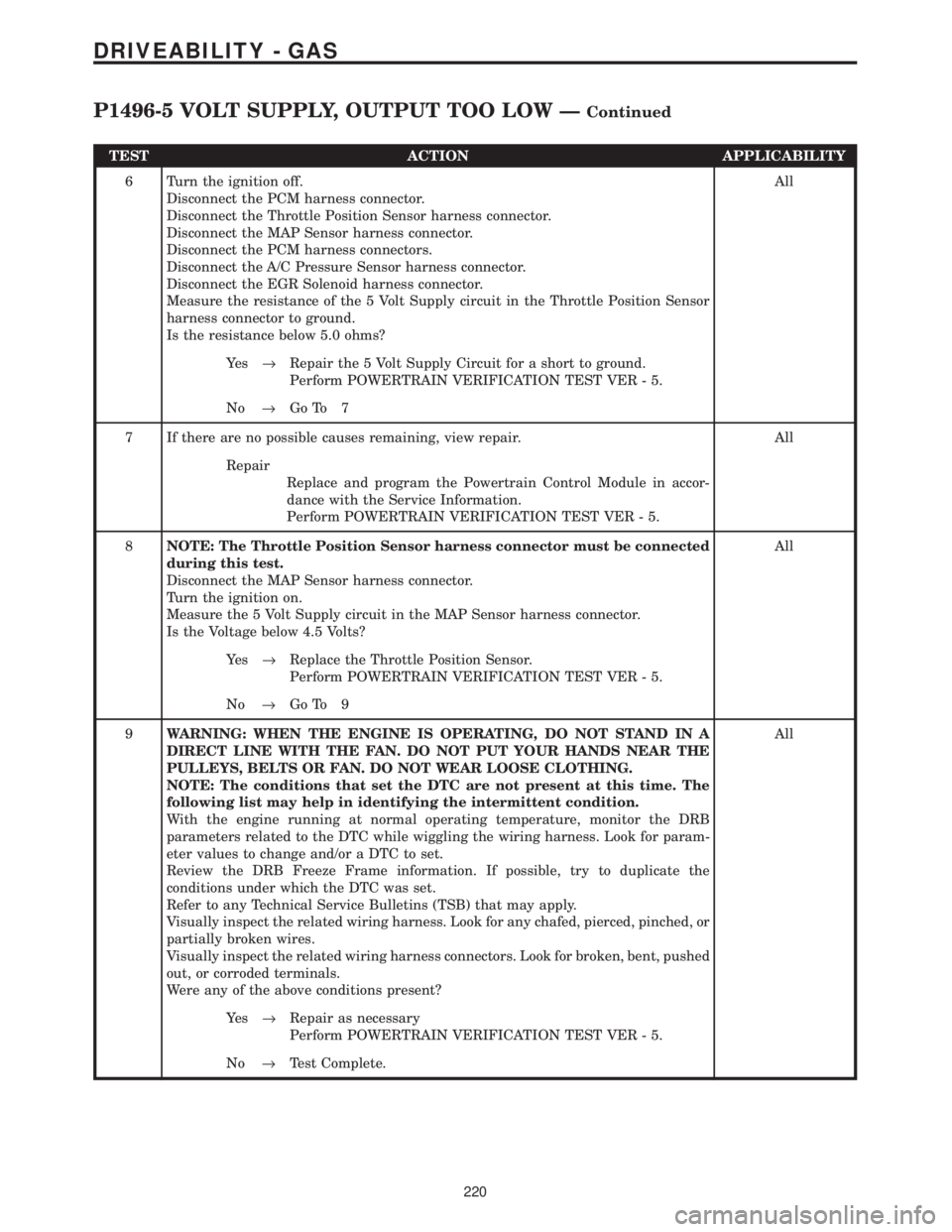
TEST ACTION APPLICABILITY
6 Turn the ignition off.
Disconnect the PCM harness connector.
Disconnect the Throttle Position Sensor harness connector.
Disconnect the MAP Sensor harness connector.
Disconnect the PCM harness connectors.
Disconnect the A/C Pressure Sensor harness connector.
Disconnect the EGR Solenoid harness connector.
Measure the resistance of the 5 Volt Supply circuit in the Throttle Position Sensor
harness connector to ground.
Is the resistance below 5.0 ohms?All
Ye s®Repair the 5 Volt Supply Circuit for a short to ground.
Perform POWERTRAIN VERIFICATION TEST VER - 5.
No®Go To 7
7 If there are no possible causes remaining, view repair. All
Repair
Replace and program the Powertrain Control Module in accor-
dance with the Service Information.
Perform POWERTRAIN VERIFICATION TEST VER - 5.
8NOTE: The Throttle Position Sensor harness connector must be connected
during this test.
Disconnect the MAP Sensor harness connector.
Turn the ignition on.
Measure the 5 Volt Supply circuit in the MAP Sensor harness connector.
Is the Voltage below 4.5 Volts?All
Ye s®Replace the Throttle Position Sensor.
Perform POWERTRAIN VERIFICATION TEST VER - 5.
No®Go To 9
9WARNING: WHEN THE ENGINE IS OPERATING, DO NOT STAND IN A
DIRECT LINE WITH THE FAN. DO NOT PUT YOUR HANDS NEAR THE
PULLEYS, BELTS OR FAN. DO NOT WEAR LOOSE CLOTHING.
NOTE: The conditions that set the DTC are not present at this time. The
following list may help in identifying the intermittent condition.
With the engine running at normal operating temperature, monitor the DRB
parameters related to the DTC while wiggling the wiring harness. Look for param-
eter values to change and/or a DTC to set.
Review the DRB Freeze Frame information. If possible, try to duplicate the
conditions under which the DTC was set.
Refer to any Technical Service Bulletins (TSB) that may apply.
Visually inspect the related wiring harness. Look for any chafed, pierced, pinched, or
partially broken wires.
Visually inspect the related wiring harness connectors. Look for broken, bent, pushed
out, or corroded terminals.
Were any of the above conditions present?All
Ye s®Repair as necessary
Perform POWERTRAIN VERIFICATION TEST VER - 5.
No®Test Complete.
220
DRIVEABILITY - GAS
P1496-5 VOLT SUPPLY, OUTPUT TOO LOW ÐContinued